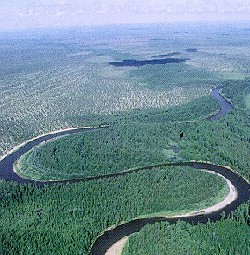Equations for a Riverdance

Like fish, river bends fight for survival and sometimes migrate upstream, according to new research. Results appearing in the April print issue of Physical Review E clarify the mechanisms by which rivers meander back and forth and sometimes remove large loops. A better understanding of river dynamics could help in the construction of bridges and homes.
Rivers are doubly fluid. Not only do they flow downstream, they also meander sideways to create bulges whose typical separation is proportional to the river width. This pattern holds for everything from small streams of glacial meltwater to the kilometer-wide Mississippi, which can move 20 meters to one side each year. A large loop in a river can even become entirely cut off when the main flow shortcuts across the loop’s neck, leaving a so-called oxbow.
Hoping to better understand these phenomena, Boyd Edwards of West Virginia University in Morgantown and Duane Smith of the National Energy Technology Laboratory, also in Morgantown, derived equations of motion for rivers. They started with a simple, 20-year-old model for meandering speed based on classical fluid mechanics, then worked out equations for the resulting evolution of the river shape. Although other groups had seen some of the same relationships before, Edwards says the new study gives a better physical understanding. “It’s amazing to me that you can get so much physics out of a simple model,” he says.
For example, Edwards and Smith’s analysis explains why large river bends grow over time, whereas smaller bends shrink, and they identified the critical length that distinguishes between the two. For smaller bends, water piles up on the outer edge of the river, raising the pressure there. Following Bernoulli’s law, the inner part of the river speeds up and erodes the inside bank, which straightens the curve over time. In larger bends, the slower-moving water near the bottom makes a tighter turn around the curve than the upper level water, creating a twisting current that carves away the outer bank. When such an expanding bulge grows to a certain size, the analysis shows that its outermost tip should move upstream as the river gradually short circuits and discards the entire length of the arc, forming an oxbow.
The equations also predict the time required for bulges to form. Unfortunately, hundreds or thousands of years are generally needed, so there’s currently not enough data to test the prediction. The history of Beatton River in British Columbia indicates that it should shed an oxbow in 2219, and researchers should be able to verify the timescale by etching rivers in sand in the lab, Edwards says. Improved predictions of river motion could help engineers plan bridge construction and keep homes clear of the Mississippi and other meandering rivers.
The new analysis has several advantages, according to Gary Parker of the University of Minnesota. The way the team derives their meandering model combines “elegance and clarity,” he says. Also, oxbow formation is usually studied numerically–by computational brute force–which is easier but doesn’t always give good insight, he adds. “The work of Edwards and Smith offers the hope of some sweet fruit to the theoretician who can pursue the analysis [even further].”
–JR Minkel
JR Minkel is a freelance science writer in New York City.


